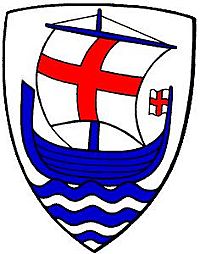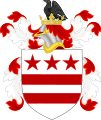Committee on Heraldry of the New England Historic Genealogical Society facts for kids

The coat of arms of the Committee.
|
|
| Founded | 1864 |
|---|---|
| Type | Heraldry society |
| Location | |
|
Area served
|
United States |
| Services | Heraldic registration and recording |
| Fields | Heraldry |
|
Chairman
|
Ryan J. Woods |
|
Parent organization
|
New England Historic Genealogical Society |
The Committee on Heraldry of the New England Historic Genealogical Society is a very old group. It was started in 1864. This makes it the world's oldest non-government group focused on heraldry. Heraldry is the study of coats of arms and family symbols.
Contents
What the Committee Does
The Committee on Heraldry was given a special job on February 3, 1864. The New England Historic Genealogical Society asked them to "collect and preserve information in regard to heraldry." This means they gather and keep records about coats of arms. They also handle all other matters related to heraldry for the society.
The Roll of Arms
The committee checks and records coats of arms that were used correctly. These are arms belonging to "American colonists, or immigrants to the United States." They also include arms of people living in colonial times who were given arms by their home countries. These historic arms are published in their book called the Roll of Arms. Only arms from before 1900 are included in this special book.
How the Roll of Arms is Published
The Roll of Arms is published in small booklets called parts. The first part came out in 1928. Each part of the roll also appears in a magazine. This magazine is called The New England Historical and Genealogical Register.
When the Roll of Arms is published, it usually shows only the shield part of the coat of arms. The shield is the main part where the symbols are. However, the text in the Roll of Arms talks about the full achievement. This means it describes the whole coat of arms, including the shield, helmet, crest, and other parts.
In 2013, the Committee on Heraldry put all the Roll of Arms parts into one big book. This book included registrations from 1 to 741. Henry L. P. Beckwith, who was the committee's secretary, edited this book. He also added a history and notes.
Registering Arms
You do not have to own a coat of arms to ask the committee to record it. Sometimes, genealogists (people who study family history) or others ask to record arms. They do this even if the arms are not from their own family. They just want to make sure these arms are officially recorded with the committee.
Recording Modern Arms
Since 1933, the Committee on Heraldry has also recorded coats of arms that cannot be in the Roll of Arms. These include assumed arms. Assumed arms are symbols created and used by people in colonial times or more recently. These arms were not officially approved by a government heraldic authority.
In 1972, the committee stopped putting arms granted in the 20th century into their Roll of Arms. These were arms given to Americans by foreign heraldic authorities. Now, these modern arms are recorded separately.
Committee History
The committee's reports on heraldry from 1899 and 1914 are very important. They are seen as key documents in the history of United States heraldry.
Committee Members
Members of the committee serve for a long time, often for life. Here are some of the members as of October 1, 2024:
- Ryan J. Woods, Chair
- Nathaniel Lane Taylor, Registrar
- Joseph McMillan, Corresponding Secretary
- Bertram Lippincott III, Corporate Secretary
- Julian V. Brandt
- Brady Brim-DeForest
- Christopher C. Child
- John Blythe Dobson
- Peter O'Donoghue, York Herald, College of Arms
- John Shannon
- D. Brenton Simons
Some famous past members include Harold Bowditch, Henry Ernest Wood, and Robert Dickson Weston.
See also
- United States heraldry
- Heraldry societies
- The Heraldry Society
- Heraldry Society of Scotland
- Royal Heraldry Society of Canada
- Royal Belgian Genealogical and Heraldic Office
- International Register of Arms
Images for kids
-
The first entry in the Roll of Arms, the coat of arms of John Washington, the great-grandfather of George Washington
-
The second entry in the Roll of Arms, the coat of arms of Samuel Appleton (1625-1696), an ancestor of Samuel Appleton.




